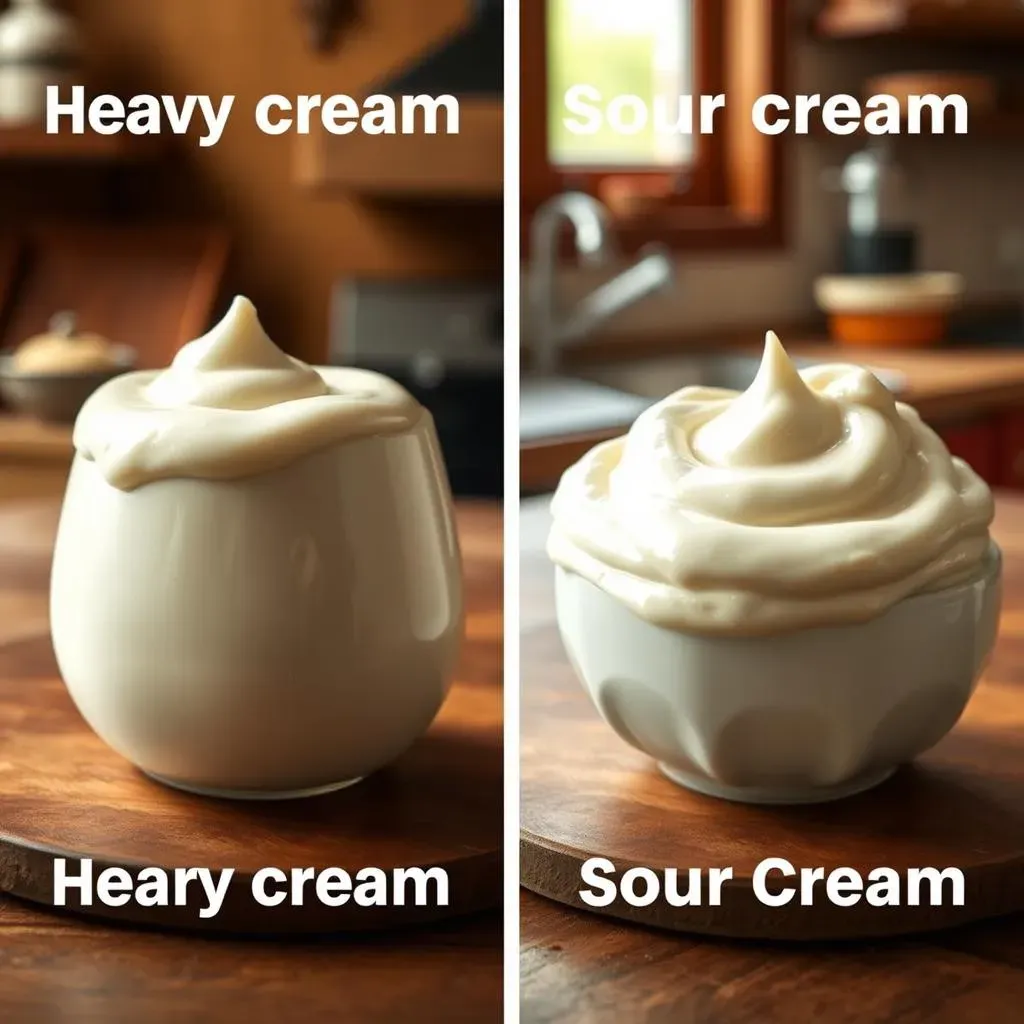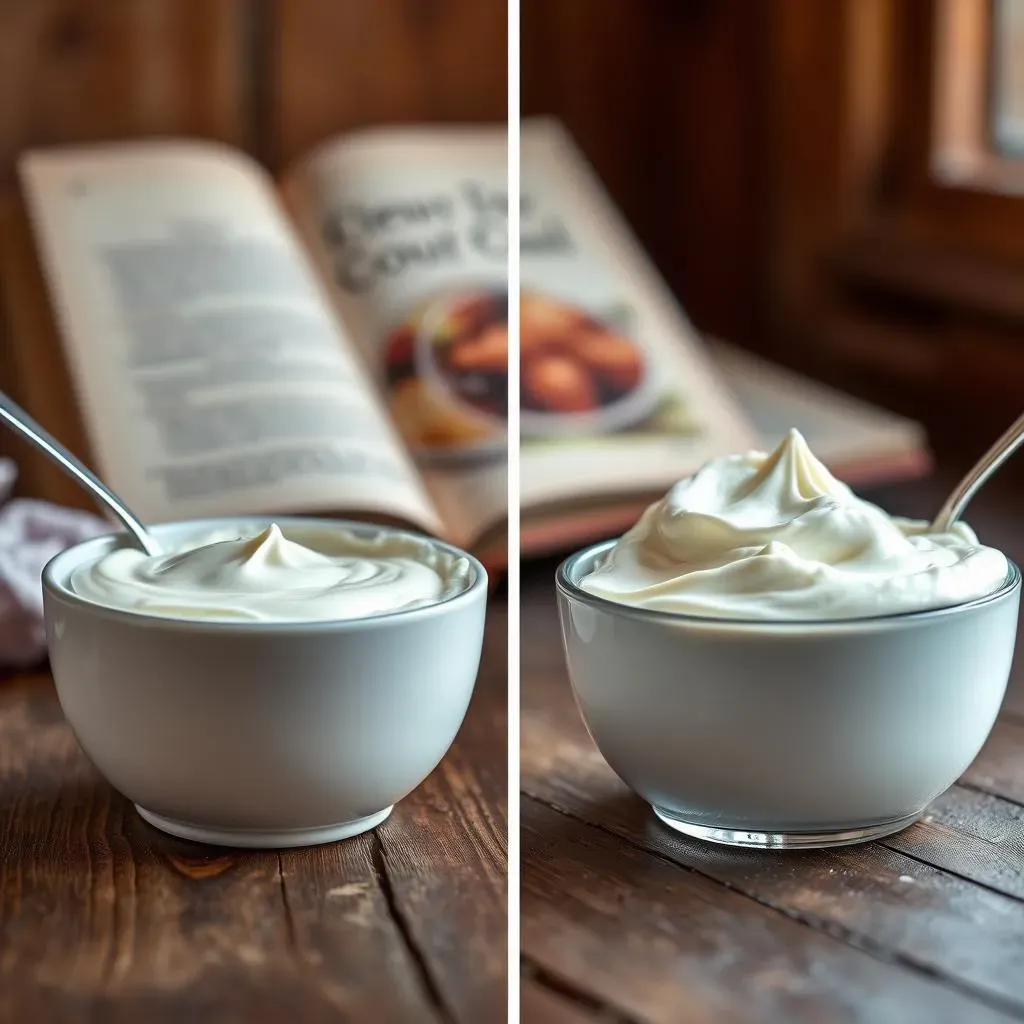Table of Contents
Ever stared blankly at a recipe, realizing you're missing a key ingredient – heavy cream? Don't panic! This article tackles the burning question: can you substitute heavy cream with sour cream? We'll explore the nuances of this substitution, examining the distinct characteristics of both heavy cream and sour cream. Understanding their differences is crucial for successful baking and cooking. We'll delve into the fat content, texture, and flavor profiles of each, revealing when a swap works wonders and when it might lead to culinary chaos. This isn't just about a simple yes or no; we'll provide practical guidance, offering tips and tricks for seamless substitutions in various recipes. Whether you're whipping up a creamy soup, crafting a decadent dessert, or simply trying to avoid a last-minute grocery run, this guide will empower you to make informed decisions about using sour cream as a heavy cream replacement. Prepare to unlock a world of culinary flexibility and discover the secrets to achieving delicious results, even when your pantry's a little less stocked than you'd hoped. Let's get started on answering the question: can you substitute heavy cream with sour cream?
Can You Substitute Heavy Cream with Sour Cream? Exploring the Possibilities

Can You Substitute Heavy Cream with Sour Cream? Exploring the Possibilities
The Big Question: Is it even possible?
So, you're staring down a recipe that calls for heavy cream, but all you've got is sour cream. Can you swap them? The short answer is: sometimes, but it depends! It's not a direct one-to-one replacement. Heavy cream is all about richness and fat content, providing a luxurious texture and subtle sweetness. Sour cream, on the other hand, brings a tangy bite and a thicker consistency. The success of the swap hinges on understanding these differences and choosing the right recipe.
Think of it like this: you wouldn't substitute ketchup for mayonnaise in a potato salad, would you? Both are condiments, but their flavors and textures are vastly different. Similarly, heavy cream and sour cream aren't interchangeable in every situation. However, with a little know-how, you can often get away with it – and sometimes even achieve surprisingly delicious results!
Ingredient | Fat Content (approx.) | Flavor Profile | Texture |
|---|---|---|---|
Heavy Cream | 36% | Rich, slightly sweet | Fluid, pourable |
Sour Cream | 20% | Tangy, slightly acidic | Thick, creamy |
When Sour Cream Can Step In (and When It Can't)
Sour cream can often successfully replace heavy cream in savory dishes. Think creamy soups, chilis, or sauces. The tanginess of the sour cream can even complement certain flavors, adding a depth that heavy cream might lack. However, the increased thickness of sour cream needs to be considered. You might need to add a little extra liquid to thin it out to the desired consistency.
On the other hand, substituting sour cream for heavy cream in desserts is a riskier proposition. The tangy flavor of the sour cream could clash with the sweetness of most desserts. The texture might also be off; while it might thicken a sauce, it won't whip up into a fluffy whipped cream. For baked goods, the acidity could affect the rise and overall texture of the final product. Proceed with caution, and perhaps even a test batch, before committing to a full-scale sour cream substitution in your favorite cake recipe.
- Savory dishes: Soups, stews, sauces – often a good substitute.
- Desserts: Cakes, frostings, whipped cream – generally not recommended.
- Important Note: Always consider the recipe's overall flavor profile before making a substitution.
Tips for Successful Substitutions
If you decide to go ahead with a sour cream swap, remember these key points. First, start with a smaller amount of sour cream than the recipe calls for. You can always add more, but you can’t take it away! Second, pay close attention to the texture of your dish as you cook. You may need to add a little milk or water to adjust the consistency. Finally, taste as you go and adjust seasonings accordingly. The tanginess of sour cream might require a slight increase in sugar or other complementary flavors.
Ultimately, substituting sour cream for heavy cream is a culinary experiment. The outcome depends heavily on the specific recipe and your own palate. Don't be afraid to experiment – and remember that even a "failed" attempt can teach you valuable lessons about flavor combinations and ingredient substitutions. Happy cooking!
Understanding the Differences: Heavy Cream vs. Sour Cream

Understanding the Differences: Heavy Cream vs. Sour Cream
Fat Content and Texture: The Core Differences
Let's get down to the nitty-gritty: fat content. Heavy cream boasts a significantly higher fat percentage (around 36%) compared to sour cream (typically around 20%). This difference is the primary reason why they behave so differently in recipes. The higher fat content in heavy cream gives it that luscious, velvety texture, perfect for whipping into airy peaks or creating rich sauces. Sour cream, with its lower fat content, has a thicker, more tangy consistency. It's less likely to separate or curdle when heated, making it a better choice for some savory dishes.
Think of it like this: heavy cream is like a silky smooth river, flowing easily and capable of being whipped into a frothy masterpiece. Sour cream, on the other hand, is more like a thick, creamy yogurt – delightful in its own right, but not quite as versatile when it comes to whipping or creating light and airy textures.
Characteristic | Heavy Cream | Sour Cream |
|---|---|---|
Fat Content | ~36% | ~20% |
Texture | Fluid, pourable | Thick, creamy |
Whipping Ability | Excellent | Poor |
Flavor Profiles: Sweet vs. Tangy
Beyond the texture, the flavor profiles of heavy cream and sour cream are quite distinct. Heavy cream possesses a subtle sweetness and richness, enhancing both sweet and savory dishes without overpowering other flavors. It's a blank canvas, ready to be adorned with other tastes. Sour cream, conversely, brings a sharp, tangy note to the party. This tanginess stems from the fermentation process used in its creation, introducing lactic acid bacteria that give it that characteristic sour taste.
Imagine this: heavy cream is a gentle whisper of sweetness, while sour cream is a bold declaration of tangy flavor. Knowing this difference is key to understanding when a substitution might work and when it might not. The tanginess of sour cream can be fantastic in savory applications, but it can easily overpower delicate desserts or clash with subtle flavor profiles.
- Heavy Cream: Subtle sweetness, richness.
- Sour Cream: Tangy, slightly acidic.
- Consider the overall flavor profile of the recipe before substituting.
Successful Substitutions: Recipes and Tips for Using Sour Cream Instead of Heavy Cream

Successful Substitutions: Recipes and Tips for Using Sour Cream Instead of Heavy Cream
Savory Successes: Soups, Stews, and Sauces
Sour cream shines in savory dishes! Its thicker consistency and tangy flavor profile often complement rich broths and hearty sauces. Think creamy tomato soup, a decadent chili, or a luscious mushroom sauce for your pasta. The acidity of the sour cream cuts through the richness of the other ingredients, adding a delightful complexity. However, remember that sour cream is thicker than heavy cream, so you might need to add a little broth or water to achieve the desired consistency. Start with a smaller amount than the recipe suggests and add more as needed, stirring constantly to prevent lumps.
Don't be afraid to experiment! The tang of sour cream can be surprisingly delicious in unexpected places. I once used it in a creamy chicken and vegetable curry, and the result was unexpectedly delicious. The subtle sourness balanced the richness of the coconut milk perfectly. Remember to taste and adjust seasonings as you go; you might need a pinch more salt or a dash of your favorite spice to compensate for the sour cream's tang.
Recipe Type | Sour Cream Substitution Tips |
|---|---|
Soups | Add a little broth or water to thin; start with less than the recipe calls for. |
Stews | Stir in towards the end of cooking to prevent curdling. |
Sauces | Whisk well to create a smooth consistency. |
Baking Cautions: When to Avoid Sour Cream Substitutions
While sour cream can be a lifesaver in savory dishes, it's a different story when it comes to baking. The acidity in sour cream can react negatively with baking soda or powder, potentially affecting the rise and texture of your baked goods. In cakes, cookies, and other desserts that rely on a delicate balance of ingredients, sour cream's tangy flavor can also clash with the sweetness, resulting in an unpleasant taste. Furthermore, sour cream's thickness won't produce the same light and airy texture as whipped heavy cream.
For example, trying to substitute sour cream for heavy cream in a delicate angel food cake recipe would be a recipe for disaster. The acidity would likely cause the cake to collapse, and the tangy flavor would completely ruin the delicate sweetness of the dessert. Similarly, using sour cream in a whipped topping would result in a dense, lumpy mess – far from the light and airy texture you'd expect from whipped cream. In short: stick to heavy cream (or a suitable alternative like full-fat coconut milk) for baking. Your tastebuds will thank you.
- Avoid using sour cream in recipes that require a light and airy texture (e.g., whipped cream).
- Be cautious when using sour cream in recipes containing baking soda or powder.
- The tangy flavor of sour cream might clash with the sweetness of desserts.
Mastering the Swap: Tips and Tricks for Success
If you're determined to use sour cream in place of heavy cream in a recipe, remember these tips for success. First, always start with less sour cream than the recipe calls for. You can easily add more, but you can't take it away! Second, consider adding a touch of sugar or sweetener to balance the sour cream's tanginess if you're using it in a savory dish that leans towards the sweet side. This can help to create a more harmonious flavor profile.
Finally, pay close attention to the texture of your creation as you cook. You might need to thin the sour cream with a little milk or broth to achieve the desired consistency. Taste as you go, adjusting seasonings as needed. Remember, even the most experienced cooks sometimes make mistakes. Don't be afraid to experiment and learn from your culinary adventures. The journey of a thousand recipes begins with a single, slightly tangy, substitution.